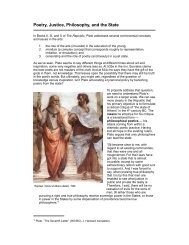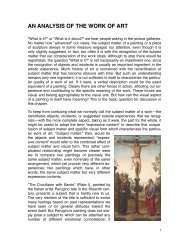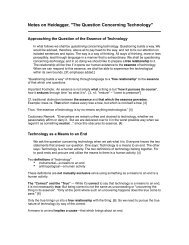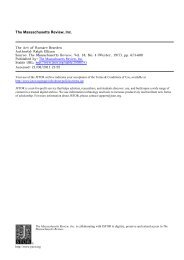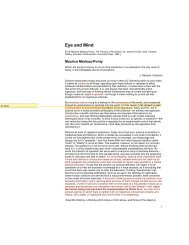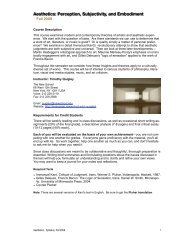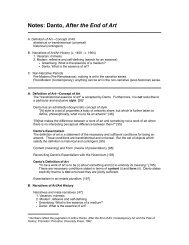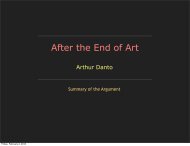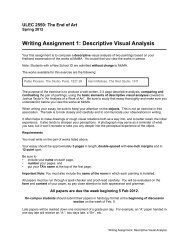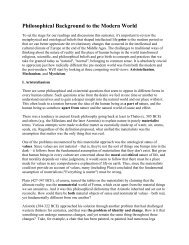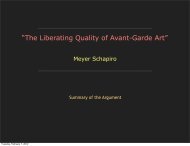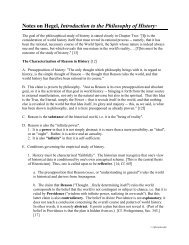Notes on Schapiro, "The Liberating Quality of Avant-Garde Art"
Notes on Schapiro, "The Liberating Quality of Avant-Garde Art"
Notes on Schapiro, "The Liberating Quality of Avant-Garde Art"
Create successful ePaper yourself
Turn your PDF publications into a flip-book with our unique Google optimized e-Paper software.
epresentati<strong>on</strong>, but rather that a new liberty had been introduced which had, as <strong>on</strong>e<strong>of</strong> its c<strong>on</strong>sequences, a greater range in the appreciati<strong>on</strong> and experience <strong>of</strong> forms. 1<strong>The</strong> emphasis <strong>on</strong> freedom and faith in the "self-sufficiency <strong>of</strong> forms and colors" took holdand shaped the most inventive and forward-looking work throughout the 1940s and '50s.It also challenged and critiqued established understandings <strong>of</strong> art and its expressivepotential.Abstracti<strong>on</strong> implies...a criticism <strong>of</strong> the accepted c<strong>on</strong>tents <strong>of</strong> the precedingrepresentati<strong>on</strong>s as ideal values or life interests. This does not mean that painters, ingiving up landscape, no l<strong>on</strong>ger enjoy nature; but they do not believe, as did thepoets, the philosophers and painters <strong>of</strong> the nineteenth century, that nature can serveas a model <strong>of</strong> harm<strong>on</strong>y for man, nor do they feel that the experience <strong>of</strong> nature’smoods is an exalting value <strong>on</strong> which to found an adequate philosophy <strong>of</strong> life. Newproblems, situati<strong>on</strong>s and experiences <strong>of</strong> greater import have emerged: the challenge<strong>of</strong> social c<strong>on</strong>flict and development, the explorati<strong>on</strong> <strong>of</strong> the self, the discovery <strong>of</strong> itshidden motivati<strong>on</strong>s and processes, the advance <strong>of</strong> human creativeness in scienceand technology.All these factors should he taken into account in judging the significance <strong>of</strong> thechange in painting and sculpture. It was not a simple studio experiment or anintellectual play with ideas and with paint; it was related to a broader and deeperreacti<strong>on</strong> to basic elements <strong>of</strong> comm<strong>on</strong> experience and the c<strong>on</strong>cept <strong>of</strong> humanity, as itdeveloped under new c<strong>on</strong>diti<strong>on</strong>s.<strong>Schapiro</strong> defends individualism and the handmade quality <strong>of</strong> painting against thehomogenizati<strong>on</strong> <strong>on</strong>e finds in mass-produced objects and the numbing effects <strong>of</strong> workthat flows not from <strong>on</strong>e's intrinsic needs and interests, but is imposed by the desires andinterests <strong>of</strong> others.This art is deeply rooted, I believe, in the self and its relati<strong>on</strong> to the surroundingworld. And the pathos <strong>of</strong> the reducti<strong>on</strong> or fragility <strong>of</strong> the self within a culture thatbecomes increasingly organized through industry, ec<strong>on</strong>omy and the state intensifiesthe desire <strong>of</strong> the artist to create forms that will manifest his liberty in this striking way—a liberty that, in the best works, is associated with a sentiment <strong>of</strong> harm<strong>on</strong>y, andthe opposite stability, and even impers<strong>on</strong>ality through the power <strong>of</strong> painting touniversalize itself in the perfecti<strong>on</strong> <strong>of</strong> its form and to reach out into comm<strong>on</strong> life. Itbecomes then a possessi<strong>on</strong> <strong>of</strong> every<strong>on</strong>e and is related to everyday experience.Notice the way <strong>Schapiro</strong> appeals to a populist value in avant-garde art—it reaches "outinto comm<strong>on</strong> life", he claims, and bel<strong>on</strong>gs to every<strong>on</strong>e. This is a utopian moment in<strong>Schapiro</strong>'s essay, but <strong>on</strong>e that reaches for an ideal and attempts to go bey<strong>on</strong>d what<strong>of</strong>fends so many as blatant elitism in Clement Greenberg's writings. Greenberg, in thatsense, is not at all utopian, but <strong>of</strong>ten seems to assume an unbridgeable gap betweenthose fortunate enough to have been educated in art and those whose circumstances inlife make it impossible. So it appears their assumpti<strong>on</strong>s may diverge <strong>on</strong> this issue.<strong>Schapiro</strong> goes <strong>on</strong> to argue that avant-garde art is radically distinct from mass mediasince its emphasis is not <strong>on</strong> communicating ideas but rather <strong>on</strong> expressive form andc<strong>on</strong>templati<strong>on</strong>.<strong>The</strong> artist does not wish to create a work in which he transmits an already preparedand complete message to a relatively indifferent and impers<strong>on</strong>al receiver. <strong>The</strong> painteraims rather at such a quality <strong>of</strong> the whole that, unless you achieve the proper set <strong>of</strong>mind and feeling towards it, you will not experience anything <strong>of</strong> it at all.1 All quotes are taken from Meyer <strong>Schapiro</strong>, “<strong>The</strong> <strong>Liberating</strong> <strong>Quality</strong> <strong>of</strong> <strong>Avant</strong>-<strong>Garde</strong> Art”, Art News(Summer 1957), emphases added.2



